#11: BRRM! BRRM!
Ed Jefferson is attempting to visit every Mews in Greater London. This week: unsinkable restaurants, stinking jam factories, and Alfred Hitchcock's nappies.
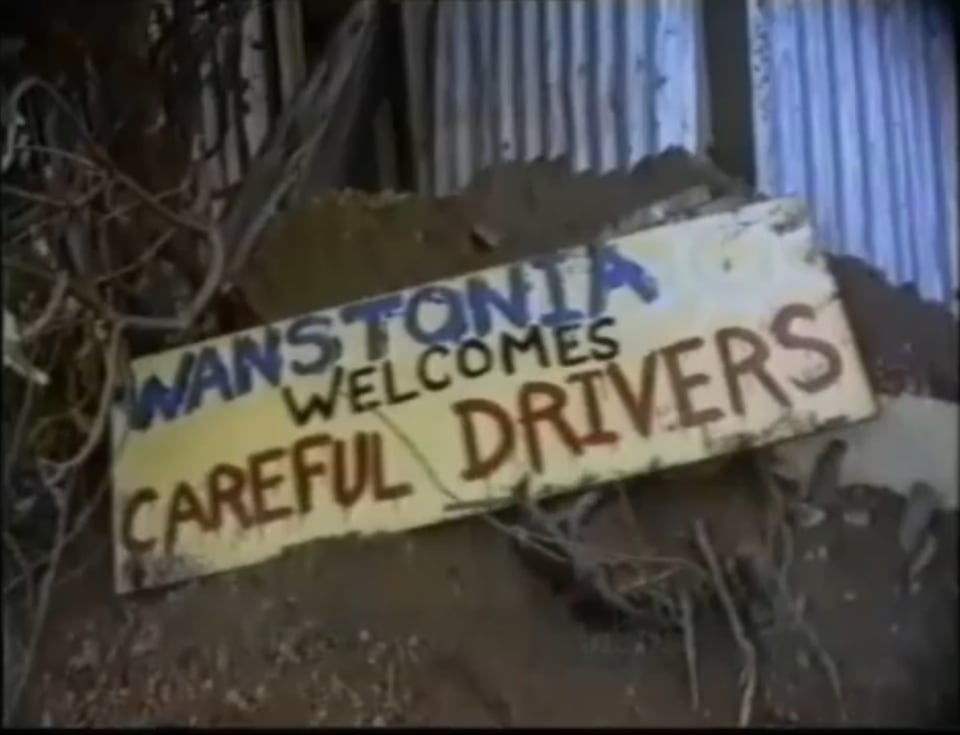
This week I have been Mewsing in the southerly bits of Waltham Forest, which is confusingly not a forest, but a borough of London named after a former forest that was mostly somewhere else (to be fair, the extant parts include Epping Forest, a fairly large section of which is in the borough)1.
As my route took me out of and then back into the south eastern corner of the borough, I had to confront perhaps a fairly dominant feature of the area - the huge six lane road cut into the landscape in London’s last great era of car-shagging, the 1990s.
Though the construction of the road (often referred to as the M11 Link Road despite the fact that it doesn’t link up with the M11) is sometimes referred to as though it created a hard geographical division, this is not strictly true - at least in Waltham Forest, it follows the route of an overground section of the Central Line which was constructed when there were, more or less literally, all fields round ‘ere. But there is a difference in scale - 2 railway tracks at ground level vs 6 lanes of road sunk metres below them, a few dozen trains per hour vs thousands of cars.
As you might expect, there was significant opposition to the road’s construction at the time, both locally and as part of a wider movement of protest against the road-building plans of the Tory government. Wanstead, just up the road, became an unlikely key battleground. As the road passes Wanstead it dips into a tunnel, which as Leyton’s Labour MP noted at the time was pretty convenient for his neighbouring constituencies’ mostly Tory voters2 - but though the end result left Wanstead relatively unaffected, the construction process did not - requiring a large section of the ‘village’ green, including a 250 year old chestnut tree, to be dug up. This radicalised a local lollipop lady, who used her role to recruit children and parents to the cause - she was subsequently fired for protesting in uniform.
Various unorthodox tactics were tried along different sections of the route to prevent the new road: in an attempt to save the tree, protestors took up residence in the branches, installed a post box and arranged for a letter delivered to it in an attempt to prove that it was in fact a dwelling. Houses due for demolition were occupied and declared part of an autonomous micronation, the Free State Of Wanstonia (a probably conscious echo of the Frestonia movement in 1970s Kensington, see Mews #8). Claremont Road in Leytonstone, due to completely disappear under the A12, was squatted almost in its entirety (the notable exception being the home of Dolly, a 92 year old resident who had lived in the street since her birth and refused to leave) - becoming a sort of combined protest camp, artist's collective and party.3
It didn’t work - though the protests caused delays and cost considerable amounts of money, the roadbuilders got their way. The tree fell, Wanstonia fell, Claremont Road fell. The final battleground was a single squatted home, Munstonia (named because it reminded people of the house from The Munsters, despite the fact that it didn’t look anything like the house from The Munsters - don’t know why no-one thought to Google it), from which the protestors were finally evicted in March 1995. The road opened 4 years later.
There’s some great documentary footage of these events on YouTube - I was vaguely familiar with the story but actually seeing it play it out in parts of London I know fairly well (or don’t know, in the case of the bits that are now the A12) is fascinating.
Though this is essentially a story of failure, it is somehow reassuring to see large numbers of people spending months protesting against roadbuilding, putting the 3 sign-waving sadsacks who hung around Wanstead for a few hours the day the Ultra Low Emissions Zone expanded into some perspective.
And, if you go onto Google Maps and type in Wanstonia, it knows you mean Wanstead. The Free Republic lives!
THE MEWSES
#101 Vanbrugh Mews, Waltham Forest, E15
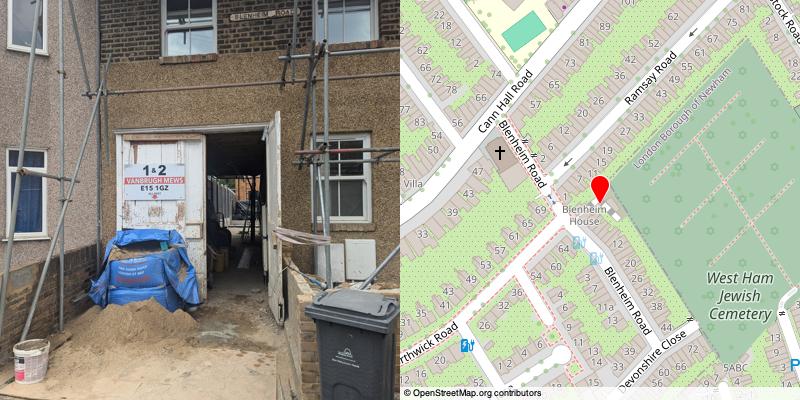
Does this count, when technically it is a Mews-to-be? Probably. A fairly typical bit of turning ex-industrial land (well, a builder’s yard) into infill housing.
The most notable thing is the name, which is nice in that someone spent more than 5 seconds thinking about it for once - Sir John Vanburgh was the architect of Blenheim Palace, of being an extremely large pile in Oxfordshire fame, Vanburgh Mews is off Blenheim Road. I bet they were well pleased when they checked Wikipedia and discovered that he hasn’t been cancelled yet.
#102 Borthwick Mews, Waltham Forest, E15

Contains an unlikely number of Jaguar cars, presumably because the eastern side is home to a specialist business called ‘Jag John’. Disappointingly this appears to have almost zero internet presence so I cannot confirm or deny whether Jag John is a good place to take your broken Jaguar car. Apologies to Jag John if he thought the weird bloke taking photos was plotting a Gone In 60 Seconds style heist, can I just assure him that I cannot even drive.
#103 Joiners Mews, Waltham Forest, E11
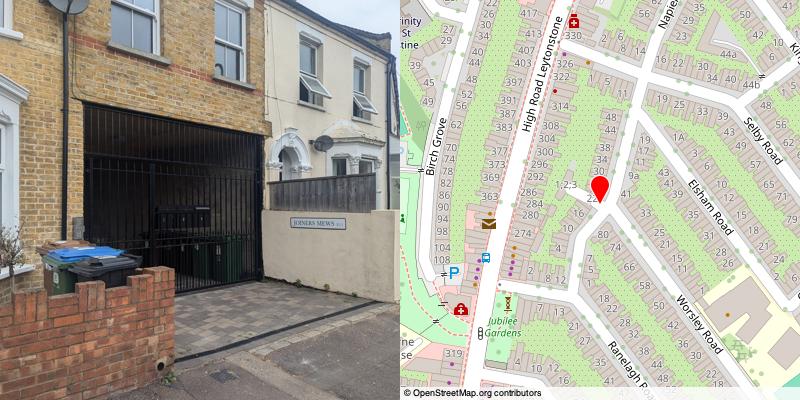
No prizes for guessing what this housing development behind Napier Road replaced, i.e. a joinery - although a 1952 planning document notes that the owners have applied for ‘continued use of building for wood bending’, so they could always have gone for Wood Benders Mews.
More recent planning documentation relating to the redevelopment for residential use notes that a resident of an adjoining property objected on the grounds of smell, which seems a bit pre-emptively judgemental about your future neighbours!
#104 Lynn Mews, Waltham Forest, E11
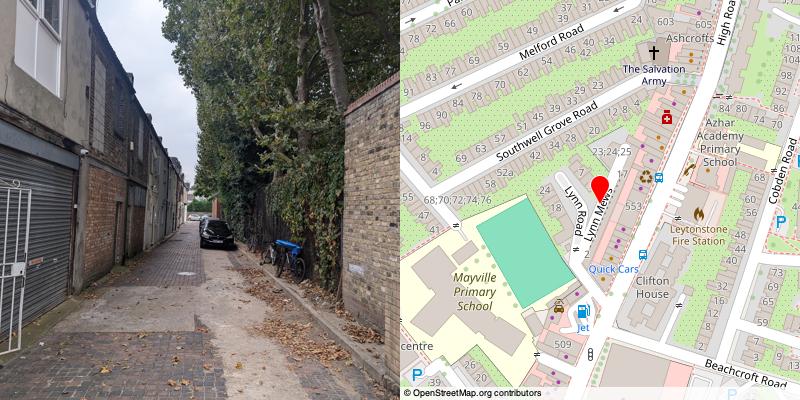
A Mews of a now mostly residential, albeit somewhat ramshackle nature, despite the best efforts of estate agents to describe it as being ‘nestled in the vibrant heart of Leytonstone’. The cars parked along the Mews are swankier than the houses, though I guess a nice car costs significantly less than a shit house in Leytonstone.
Just round the corner from where Alfred Hitchcock was born: there’s a blue plaque on the garage now occupying the site of his birth, a mural of some birds (as in The) on a nearby building, and some more birds (as in The) etched into the pavement outside said building. Leytonstone is extremely proud of Hitchcock having been born there - the tube station also has various Hitchcock-related art, there’s a pub called The Birds and a hotel called the Sir Alfred Hitchcock. The detail that he only live there until he was 6 years old is apparently not that important - in my opinion they should replace all the The Birds (shot in California) stuff with plaques saying e.g. ‘Alfred Hitchcock done in it his nappy and all down his legs here’.
#105 Owens Mews, Waltham Forest, E11
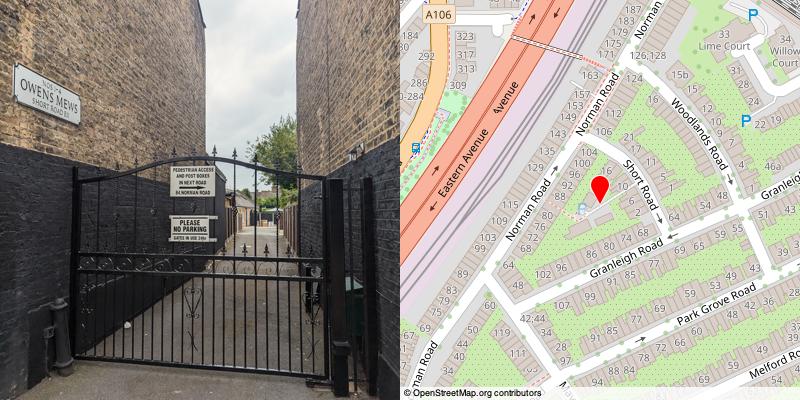
Turn of the 20th century infill development with not one but TWO gates - separate ones for pedestrians and cars, which is some real pervert shit.
Was formerly home to a central heating manufacturer called ‘Warmback’ who, judging by a number of 1970s news stories about angry council tenants, manufactured fairly crap central heating systems.
#106 George Mews, Waltham Forest, E11
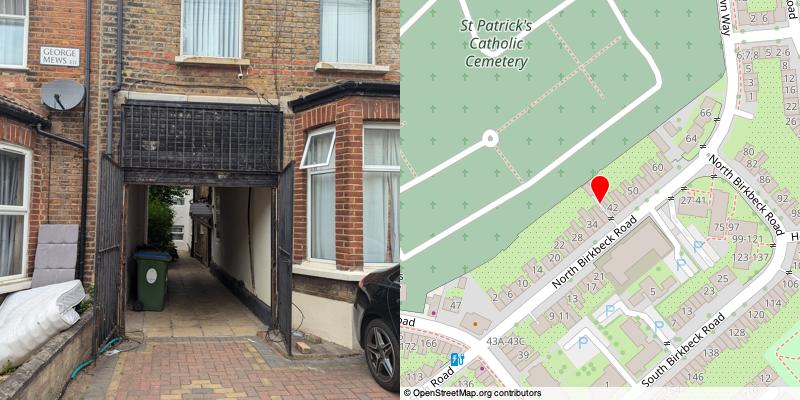
A mystery. George Mews appears to be an alleyway leading to some kind of property behind one of the houses on North Birkbeck Road. The sign for it appears to be from the last couple of years but I couldn’t find anything about in Waltham Forest’s planning database - there’s been some building back there since at least 1999, judging by Google Earth’s historical aerial photography, but beyond that, answers on a postcard.
Speaking of post, for some reason it merits its own postcode - when you put that postcode into Google Maps the boundaries include only this property and a swathe of graves in St Patrick’s Catholic Cemetery behind (presumably because of the vagaries of mapping software rather than it being possible to post letters to the dead). Disappointingly it is a few yards short of including the grave of Stephen Lewis, who played Blakey in the deeply depressing olden days sitcom ‘On The Buses’. I understand that if you watch an episode of it these days, it sounds an alert at the nearest police station for them to come and search your hard drive.
#107 Miller Mews, Waltham Forest, E10
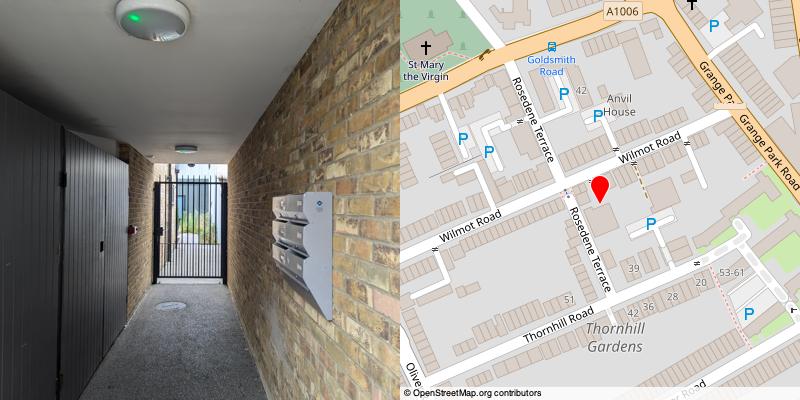
Yet another ex-industrial site converted into a little gated residential block. The building formerly on the site was called Miller House, and was home a printing company, Radford Press. In 1990 they and several other businesses paid for a page in the Harlow Star congratulating a firm of solicitors called ‘Whiskers’ on opening a new office. I don’t know why they would bother to do that, but hey, whatever kept the lights on at a local newspaper I guess.
Whiskers (who sadly aren’t cat solicitors or anything- there was at some point a Mr Whisker who was a human man with thumbs and that) have an ‘interesting’ client - Carly Burd, who last year went viral and raised loads of money on GoFundMe after claiming someone chucked a load of salt on her allotment and making a video of herself crying. Given that she has legal representation and I don’t, it may not be advisable to get into specifics but there have certainly been some interesting follow-up news stories about this!
#108 Craft Mews, Waltham Forest, E10

They really don’t want you to know what’s going on in Craft Mews, but I tried my best at peering through the tiny holes in the gate and can exclusively reveal that they’ve got some bin cupboards.
Was until 2020 a row of “partially dilapidated” garages - the redevelopment’s design and access statement boasts that the shared garden maintains a “connection to the area and its history” because you can see the top of St Mary’s church over the back wall. If you can get in.
Much of the land immediately surrounding the site was the first half of the 20th century occupied by the Laurie’s Preserves factory. I haven’t been able to dig up what happen to Laurie’s, either long since out of business or absorbed into some other preserve conglomerate, but it appears they were not necessarily fondly remembered in the area: comedy writer Frank Muir4 noted in his autobiography that on returning to his Leyton home while on leave during the war that he found himself wishing the Germans would bomb the factory, so disgusting was the smell.
#109 Elizabeth Mews, Waltham Forest, E10

As an industrial site was home to a pipework company and something mysterious with the baffling name of ‘Applecod’. Speaking of baffling names, the architecture firm responsible for the conversion into six houses is called “PLOp Designs”… why? Why would you do that? Why wouldn’t anyone say anything before you did that? Please come to my lovely new house, designed by TUrd.
#110 Smithys Mews, Waltham Forest, E10
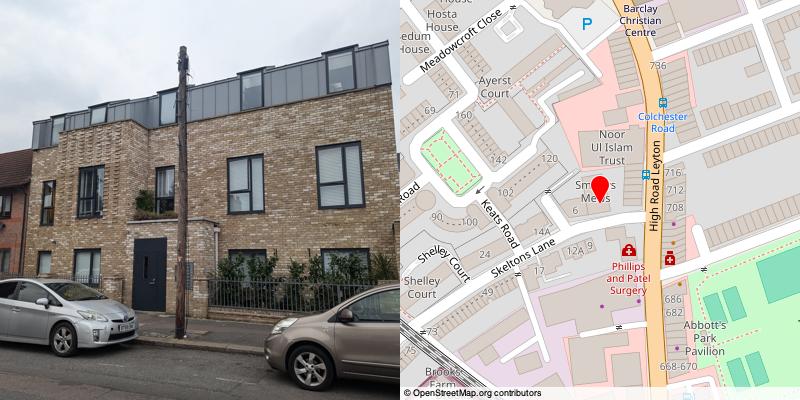
“Smithys” presumably because old maps of the area have an ambiguously-placed label indicating that there was a smithy somewhere near here. An edition of the Eastern Mercury published on Tuesday 21 November 1911 congratulates local farrier Robert Priest on reaching his 87th birthday, though I’m not sure if a farrier really counts as a smith because they only do horseshoes. Still, would give a pleasing connection to the old horse-based meaning of Mews if it was. There is no corresponding congratulation on 21 November 1912, :-(.5
Built on what was previously a secondhand car dealership that appears to have at one point been called ‘Olympic Motors’, which was presumably some sort of attempt at reflected glory about the 2012 Olympics happening just down the road, as though that makes any difference to the old bangers you’re flogging. They don’t even let the athletes drive cars in the Olympics! Still, while I was checking this lot of Mewses out I passed a restaurant called ‘Titanic’ and I have even less idea what they want you to think about that.
MEWSES VISITED SO FAR:
110/2380

Still, could have been worse, when they were trying to work out what to call the borough in 1963, one of the suggestions was ‘Sorensen Spread’. (No idea, but would hazard that this may have been from a member of the public making a sarcastic reference to the then MP for Leyton, Reginald Sorensen). ↩
If this was the plan, it may have been a miscalculation, as a boundary review held before the 1997 election united Leyton and Wanstead as a very safe Labour seat - the Tory voters in the old constituency were presumably up the road in Woodford. ↩
These elements were not always harmonious - a contemporary article notes that some resentment built up around 'lunch outs' - those who were more interested in drinking strong lager than they were in manning the barricades, leading to expulsions from the community. ↩
Who commissioned On The Buses (see #106) when he ran LWT’s entertainment department. ↩
I wonder whether Robert Priest was ever an older farrier than London’s Oldest Farrier Tom Bunn, see Mews #2 here. ↩
Add a comment: